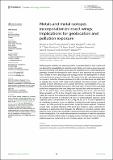Por favor, use este identificador para citar o enlazar a este item:
http://hdl.handle.net/10261/295404COMPARTIR / EXPORTAR:
 SHARE SHARE
 CORE
BASE CORE
BASE
|
|
| Visualizar otros formatos: MARC | Dublin Core | RDF | ORE | MODS | METS | DIDL | DATACITE | |

| Título: | Metals and metal isotopes incorporation in insect wings: Implications for geolocation and pollution exposure |
Autor: | Reich, Megan S.; Kindra, Mira; Dargent, Felipe; Hu, Lihai; Flockhart, D. T. Tyler; Norris, D.Ryan; Kharouba, Heather; Talavera, Gerard CSIC ORCID; Bataille, Clément P. | Palabras clave: | Metal isotopes Strontium isotopes (87Sr/86Sr) Lead isotopes Isotope-based geographic assignment Chemoprint Monarch butterfly (Danaus plexippus) Metal pollution |
Fecha de publicación: | 13-feb-2023 | Editor: | Frontiers Media | Citación: | Front. Ecol. Evol. 11(2023) | Resumen: | Anthropogenic activities are exposing insects to elevated levels of toxic metals and are altering the bioavailability of essential metals. Metals and metal isotopes have also become promising tools for the geolocation of migratory insects. Understanding the pathways of metal incorporation in insect tissues is thus important for assessing the role of metals in insect physiology and ecology and for the development of metals and metal isotopes as geolocation tools. We conducted a diet-switching experiment on monarch butterflies [Danaus plexippus (L.)] with controlled larval and adult diets to evaluate the sources of 23 metals and metalloids, strontium isotopes, and lead isotopes to insect wing tissues over a period of 8 weeks. Concentrations of Ca, Co, Mo, and Sb differed between the sexes or with body mass. Ni and Zn bioaccumulated in the insect wing tissues over time, likely from the adult diet, while increases in Al, Cr, Cd, Cu, Fe, and Pb were, at least partially, from external sources (i.e., dust aerosols). Bioaccumulation of Pb in the monarch wings was confirmed by Pb isotopes to mainly be sourced from external anthropogenic sources, revealing the potential of Pb isotopes to become an indicator and tracer of metal pollution exposure along migratory paths. Concentrations of Ba, Cs, Mg, Na, Rb, Sr, Ti, Tl, and U appeared to be unaffected by intrinsic factors or additions of metals from adult dietary or external sources, and their potential for geolocation should be further explored. Strontium isotope ratios remained indicative of the larval diet, at least in males, supporting its potential as a geolocation tool. However, the difference in strontium isotope ratios between sexes, as well as the possibility of external contamination by wetting, requires further investigation. Our results demonstrate the complexity of metal incorporation processes in insects and the value of studying metals to develop new tools to quantify pollution exposure, metal toxicity, micronutrient uptake, and insect mobility. | Versión del editor: | https://doi.org/10.3389/fevo.2023.1085903 | URI: | http://hdl.handle.net/10261/295404 | DOI: | https://doi.org/10.3389/fevo.2023.1085903 | Identificadores: | doi: https://doi.org/10.3389/fevo.2023.1085903 e-issn: 2296-701X |
| Aparece en las colecciones: | (IBB) Artículos |
Ficheros en este ítem:
| Fichero | Descripción | Tamaño | Formato | |
|---|---|---|---|---|
| Reich_et_al_2023.pdf | 2 MB | Adobe PDF |  Visualizar/Abrir |
CORE Recommender
Page view(s)
104
checked on 19-may-2024
Download(s)
45
checked on 19-may-2024
Google ScholarTM
Check
Altmetric
Altmetric
Este item está licenciado bajo una Licencia Creative Commons

